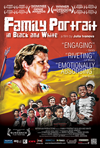Roles of a Lifetime | Halle Berry
The New York Times Magazine
2012-10-20
Joyce Maynard
It’s 10 in the morning, and already Halle Berry is being chased, though a better word for what’s going on might be “hunted.” Considering this, the Oscar-winning actress — one of the stars of the film “Cloud Atlas” — makes her way into the lounge of the Four Seasons Hotel as if emerging from savasana at the end of a two-hour yoga class. Her smile appears warm, her outfit (perfectly ripped jeans and a T-shirt) unremarkable. Her hair — back to the short cut she has favored over the years, that only a woman this beautiful could pull off with such success — looks great though un-fussed-over, as does the rest of her, never mind that she just celebrated her 46th birthday. She doesn’t carry herself like a woman under siege.
“They’re outside my house every morning,” she says. We’re speaking of the paparazzi, of course. Even here in L.A. — a town not short on movie stars — Halle Berry gets special attention from the press. Not the good kind.
“I get it about the celebrity stuff,” she tells me softly, sliding into her seat. “It’s part of my job to recognize that there’s a certain part of my life the public wants to hear about. But it’s not O.K. that they’re doing terrible things to my daughter. One night, after they chased us, it took me two hours just to get her calmed down enough to get to sleep.”…
…Berry grew up in Cleveland as the child of a white mother (a psychiatric nurse) and a black, alcoholic father — a hospital orderly — who abused her mother and older sister (not Berry herself, she says), and who left when she was 4. He returned six years later for what she describes as “the worst year of my life.” But it was her mother, Judith, who raised her.
After her mother showed up for the first time at her all-black elementary school, Berry was shunned. “Kids said I was adopted,” she says. “Overnight, I didn’t fit in anymore.” When the family moved to the suburbs in search of a better education for Berry and her sister, she was suddenly the lone black child in a nearly all-white school. People left Oreo cookies in her locker. When she was elected prom queen, the school principal accused her of stuffing the ballot box and suggested she and the white runner-up flip a coin to see who got to be queen. Berry won the toss.
“I always had to prove myself through my actions,” she says. “Be a cheerleader. Be class president. Be the editor of the newspaper. It gave me a way to show who I was without being angry or violent. By the time I left school, I had a lot of tenacity. I’d turned things around.”
When she was 16, her mother stood with her in front of a mirror and asked what she saw. “My mother helped me identify myself the way the world would identify me,” Berry says. “Bloodlines didn’t matter as much as how I would be perceived” — as beautiful but also as a black woman in a world in which the images of beautiful, successful black women were notably absent.
In the late 1960s, when Berry was a toddler, it wasn’t hard to find a black maid on the screen, large or small. But except for Diahann Carroll, and Nichelle Nichols on “Star Trek,” there were virtually no glamorous black leading ladies on television. Before that, on the large screen there had been Dorothy Dandridge, a serious actress and singer, but one who never came close to achieving the fame or success of her white contemporaries Grace Kelly and Marilyn Monroe. Among Oscar winners, the only name on the list: Hattie McDaniel, for her role as the maid in “Gone With the Wind.” (And in 1990, Whoopi Goldberg, as Best Supporting Actress in “Ghost.”)
A similar problem faced her at home. “My mother tried hard,” Berry says. “But there was no substitute for having a black woman I could identify with, who could teach me about being black.”
A black school counselor named Yvonne Sims entered her life in fifth grade. She remains one of Berry’s closest friends. “Yvonne taught me not to let the criticism affect me. She inspired me to be the best and gave me a model of a great black woman.”…
…Berry identifies herself as African-American, and in her acceptance speech for the Oscar, she chose to honor Dorothy Dandridge, Lena Horne and Diahann Carroll. Yet spending time with Berry, I have the feeling that more than belonging to one race or another, what she feels like most is an outsider.
We speak of her own experience, but also that of President Obama. She hasn’t met him, but she attended the inauguration and feels a connection to another dark-skinned child of an absent black father, raised by a white mother. “Being biracial is sort of like being in a secret society,” she says. “Most people I know of that mix have a real ability to be in a room with anyone, black or white.”…
Read the entire article here.
